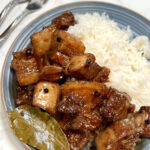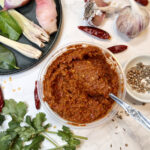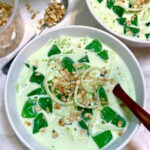Buko Pandan is a creamy, tropical dessert made with strips of coconut and pandan-flavored jelly. It’s refreshing and perfect for get-togethers or simply as an afternoon snack.
What is Buko Pandan?
The name buko pandan is derived from the two main ingredients of this dessert, buko which is a young coconut, and pandan, a green aromatic plant used widely in Southeast Asian cuisine.
In its basic form, the dessert contains pandan-flavored gulaman (jelly), strips of buko, and mini tapioca pearls mixed with a sweet cream mixture.

It is said to have originated from the eastern Visayas region on the island of Bohol. Influenced by American occupation, locals tailored the idea of an American fruit salad to suit Filipino tastes, compiling buko strips and jelly along with cream.
Nowadays, buko pandan has evolved tremendously across the Philippines, with each region and household preparing their own versions of this dessert. It’s become so popular that buko pandan had become a staple flavor combination in the Philippines, being converted into iced drinks (palamig), cakes, and even ice cream!
Buko pandan is typically served during special occasions or get-togethers. My mom always brought a huge tub of this stuff to potlucks, where the guests would just grab their own cups/bowls to ladle themselves a good serving of buko pandan for dessert.

What Does Buko Pandan Taste Like?
The main flavor profile of this dessert is sweet and creamy, primarily flavored by the pandan. The best way I could describe pandan is very floral, aromatic, somewhat grassy, with a hint of vanilla. It’s hard to describe until you actually give it a try, but its flavors work so beautifully with the young coconut.
Apart from the pandan, the young coconut strips give the dessert a great textural element. They’re soft and chewy, with a naturally sweet flavor.

Some recipes will add coconut juice, which can help to flavor the dessert with a more obvious coconut taste. Others will mix in nata de coco (coconut gel) or kaong (sugar palm fruit) that can also introduce different textures and sweetness into the mix.
Ingredient Notes
While this isn’t a very intricate dish, I did want to make a couple notes regarding the ingredients since there seems to be a bit of variations in terms of how it’s prepared in the West and the motherland. Note that most of these ingredients you can find in either your local Filipino grocery/convenience store or in an Asian supermarket.
Gulaman: This is Filipino dried agar, which exists as both as a bar, or in powdered form. Both types can work in this recipe, but I ended up using the powdered version that comes in convenient packets (it’s also already flavored with buko pandan so it makes prepping it incredibly easy).
Some recipes will call for you to use unflavored gulaman, which would then require you to manually flavor the jelly with either pandan extract or infusing the pandan leaves themselves. Whichever option you choose, the end result will all be fairly identical to each other, so there’s really no right or wrong answer here.

Buko (young coconut): Being in the West, finding fresh buko can be a challenge sometimes, so most people would just opt for the frozen kind. If you have access to fresh buko, by all means, go for it (and I’m highly jealous of you).
A trick my mom taught me (regardless if you use frozen or fresh buko) was to drain the buko juice from the flesh completely, and briefly rinsing the strips with hot water prior to mixing it with the cream. This is because the coconut juice has a tendency to spoil and curdle desserts faster when included.

All-Purpose Creamer: Like the name, this creamer is used for all sorts of things in the Philippines (not just desserts, it’s even for savory dishes!). This adds a nice richness to the cream mixture of buko pandan and gives the dessert a velvety mouthfeel.
I find that this creamer is a bit tougher to find in my area, so if you’re also struggling, some great substitutes include thick cream or heavy cream.

Pinipig (flattened glutinous rice): This ingredient is totally optional. Just be sure to toast it slightly in a pan until golden to wake its flavors up a bit. Normally I would say that a good substitute for pinipig is either corn flakes or rice krispies (such as for Halo Halo, for example), but this time, I’d say to omit it if you can’t find pinipig at all. It honestly just looks a little odd with those cereals on top of buko pandan, and I want to save you from your Filipino friends raising an eyebrow. Trust me.
Instructions for Buko Pandan
Begin by preparing your gulaman (jelly) by following the packaged instructions. Transfer the liquid mixture into a large heat-proof container to chill and set while you prepare the rest of the ingredients.

Prepare the small tapioca pearls by bringing a pot of water a boil. Once boiling, throw in the tapioca pearls and turn down the heat to a medium-low. Let the pearls cook for around 15 minutes (stirring constantly to avoid sticking/burning), or until the pearls are translucent and no longer white in the centre. Drain, and rinse with cold water immediately to retain their chew. Set aside.
In a large container or bowl, combine together the all-purpose cream, condensed milk, and evaporated milk. Whisk to combine until smooth.

Once the jelly is firm, slice into 1-inch cubes.

Add the cubed jelly, cooked tapioca pearls, and young coconut strips into the cream mixture (you may also add the drops of pandan extract at this time if you prefer to intensify the buko-pandan flavor). Stir gently to combine. Taste and adjust the consistency to your preference.

Let chill in the refrigerator overnight before serving. Top with toasted pinipig and enjoy!

Looking for more delicious dessert ideas? You might love these:
Disclosure: Some links on this page are affiliate links, meaning that at no additional cost to you, we may receive compensation from purchases made through these links. As an Amazon Associate, I can earn from qualifying purchases.







